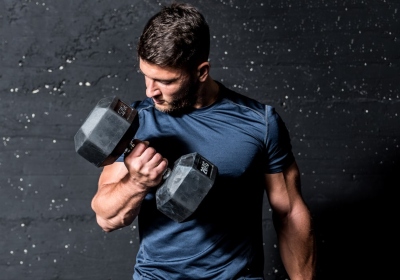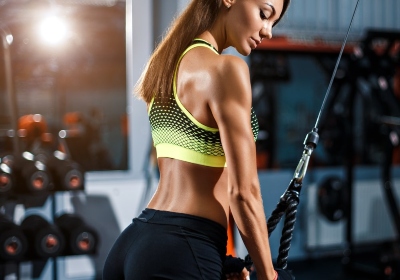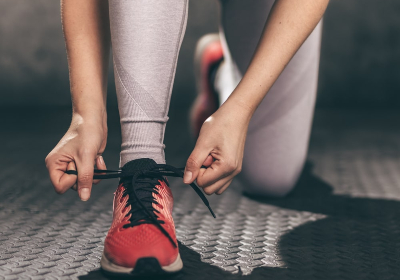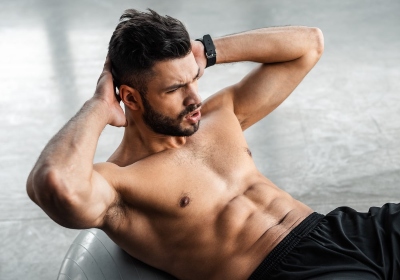RECOMENDED FOR YOU - TRAIN YOUR CALVES
Jump Rope, Front Straddles
- Quads
- Hamstrings
- Calves
Level:Beginner
Trainer:Nick Taylor
Equipment:Jumping Rope
Keeping your hands at hip level, hold the rope. Rotating your wrists to swing the rope, jump so that the rope skip under your feet. Keep jumping with both feet at the same time, then one foot, alternating feet change, etc. Repeat until your set is complete.
save to ...
TRAINING FOR LEGS: EXERCISE 1
- Biceps
- Gluteus
- Hamstrings
Duaration: 00:49
save to playlist
Delete
- Core
- Gluteus
- Hamstrings
Duaration: 00:45
save to playlist
Delete
- Gluteus
- Lower Back
- Quads
Duaration: 00:51
save to playlist
Delete
ARTICLES
Biceps is the most famous muscle in the human muscular system, it is approximately one-third of the mass of the shoulder. It is a part of a group of three in the upper arm that works together with each other to lift the arm toward the shoulder. As one of the most visible and impressive parts of the body, “two-headed muscles” are often the gym’s focus.
It is responsible for two main movements of the arm. The first is raising your hand. Those who carry something using their arm are likely to engage them in the process, as some upward force must be applied during the process of carrying and lifting. The second movement, for which they are responsible, is called supination, which rotates the arm from the natural position of the palm down to the palm up.
Biceps are built as a result of injury, which is often achieved through lifting weights such as curls or other types of exercises. As the curls or other exercises are done, the muscles in the arm get minor injuries. These injuries must be repaired naturally. The recovery process, as a natural byproduct, usually leads to growth and strength gains, although this process can take several weeks or months before noticeable results are seen.
Very few exercises work for it without affecting the other parts of the shoulder. Therefore, there is no reason to worry that others in the upper arm might be neglected by focusing on them. Some may focus only on the arm and almost completely forget about the legs or the core.
As one of the most commonly used muscles in the body, the biceps can certainly be damaged. Biceps injuries are not as common as some other types of injuries, there is always a risk, especially among weightlifters. The most common type of injury is damage to the tendon. In this type of injury, It is pulled away from the tendon that attaches it to the arm in a bone also known as the radius. Such injuries occur when they are used suddenly or to a level that they cannot handle.
Training.
Dumbbell Bicep Curls. Stand straight with the dumbbell in each hand and with your feet shoulder-width apart. Once the dumbbells are at your shoulder level, start slowly lower your arms to the starting position. Repeat for the desired amount of repetitions.
Incline Pushup. Place your hands slightly wider than shoulder-width apart on a bench, chair, or couch. And assume a high plank position with your feet together and your body straight from head to heels. Keeping your feet flat and core engaged lower your chest to the bench or chair. Pause. And then push yourself back up to the starting position.
Diamond Knee Pushup. With your knees on the ground place your hands on the ground with your fingers and thumbs touching together creating the diamond shape. This action will engage more your tricep muscle. Then complete a push-up and get back to the starting position. Repeat for the desired number of repetitions.
Pike Pushup. Assume a shorter push-up position, get on your toes and put your butt up, shifting your weights to the front. Bending your arms slowly lower your head, be sure not to bump your head on the ground.
Read more
The muscle on the back of your shoulder is called the triceps. Triceps originate from the scapula and humerus and attach to the ulna using the triceps tendon. The triceps muscle does the function of extension in the elbow and acts as an auxiliary in the implementation of other movements in the shoulder. During triceps contraction, the vector of movement is transmitted using the tendon.
The mass fraction of the triceps is approximately 2/3 of the muscles of the shoulder, so its size plays a critical role in the formation of beautiful arms. By focusing on the biceps, and forgetting about the triceps muscle, athletes contribute to getting inharmoniously developed arms.
You shouldn't train your triceps more often than 1-2 times a week. Do not forget that many exercises for the pectoral muscles load the triceps, so make up the training program so that the triceps and pectoral muscles are trained on different and distant days, thus some periodization of the load is achieved.
But in some cases, the triceps can be trained on the same day as the pectorals, since all basic chest exercises involve the triceps and vice versa. This means that if you swing your chest, then the triceps already swing by themselves. To increase efficiency, do triceps workouts of different intensities: light-medium-hard, and so on. Rest for at least 1 week after a hard workout.
In classic splits, the triceps are usually the most overloaded muscle, due to the very specifics of training in split programs. To increase the volume of the triceps muscle, do 8-15 repetitions. The total number of triceps sets (the sum of the sets of all triceps exercises) is 3-6.
The basic exercises for pumping triceps are reverse push-ups on the bench and narrow grip barbell press. In addition, an important exercise is a pull of the upper block with a rope - one of the few that uses the lateral head in the work. Since the mechanics of movements are in many ways similar, it is recommended not to combine the presented exercises, but to alternate.
Training.
Reverse push-ups from the bench. Starting position - heels touch the floor, hands on the bench behind your back. Slowly lower your torso down, linger at the bottom point, then with an explosive force push your body weight up over the bench. The elbows are directed backward. To complicate things, use an extra load by putting the weight on your hips.
Bench press with a narrow grip. It’s the exercise to work out the medial head of the triceps. Lie on a bench (keeping your feet firmly on the floor), grab a barbell or dumbbell with a narrow grip, then lift the weight up. During execution, the elbows should be pressed as close to the body as possible.
Bent over triceps extension. It’s for pumping the long and lateral heads of the triceps. When pulling the arm back, make sure that the elbow does not change position (that is, do not swing the arm back and forth or left and right). Also, watch out for the arch of the back - to do this, keep the abs slightly tense.
Top pulldown with rope. A key exercise for pumping the lateral head of the triceps. The movement should be in the lower plane - that is, do not raise your arms higher than chest level. When doing it, make sure that the elbows do not change position, and the body does not swing.
Remember that when building the triceps, you need to correctly feel the amplitude of the exercises - achieving maximum involvement of the muscles without dangerous impact on the shoulder joint. For this, it is better to use an average working weight.
Furthermore, watch your shoulders and head - in particular, don't round your shoulders or lean forward. When doing triceps exercises, the chest should be open, the press should be tense. Otherwise, the load is transferred to the shoulder joints.
Read more
In bodybuilding and fitness, the deltoid muscles play a special part. Despite the fact that the muscle area belongs to small groups, it is second only to the biceps in terms of training frequency. The reason lies not only in the importance of the deltoid muscles in the anatomy but also in improving the aesthetics of the figure. Understanding the functions and features of the deltoid bands allows you to maximize the effectiveness of the training process and significantly reduce the injury risk.
The deltoid muscles consist of three heads (bundles):
The anterior head (anterior bundle) attaches to the humerus and is responsible for lifting the arm forward.
The middle head (lateral bundle) is attached to the acromion of the scapula and allows the arm to be lifted sideways.
The posterior head (posterior bundle) is attached to the scapula and allows the arm to be moved backward.
The deltoid muscle covers the shoulder joint. The muscle is thick, triangular in shape, with the base up and the apex down. It consists of large muscle bundles, which fan-like converge at the apex. It starts from the clavicle and scapula and attaches to the deltoid tuberosity of the humerus.
In training the deltoid muscles, it is very important to pump all three bundles equally. This will protect the shoulder joint from injuries.
The deltoid muscle bundles have different functions, so you cannot work them all with just one exercise: you must include at least three movements in your workout.
You must correctly select exercises for pumping the front, middle and rear bundles. Choose one exercise from each category and add them to your workouts.
Shoulders should be trained no more than twice a week (once is enough for beginners), this will allow the muscles to fully recover for the next workout.
Here is some basic exercises for deltoids:
The army bench press or barbell/dumbbell press in standing or sitting position (middle, front).
Bench press from behind the head while seated (middle, front).
Chin-up or 'broach' barbell pull (middle, front).
Lee Heini pulls (back, middle).
Arnold press (front, middle).
Read more
The anatomy of the human foot is complex. This is a part of the leg with many muscular compartments that perform functions such as balancing, maintaining stability, softening the impact of steps, creating solid support. Its structure allows us to see how evolution has adapted our body to an efficient way of movement - upright walking. Anatomically, it is similar to the hand.
The anatomical structure of the foot is quite complex, due to the need for a small support area to support the weight of the human body. There are two parts distinguished in the foot: a plantar surface (which is in direct contact with the ground) and an opposite - dorsiflexion.
All parts of this very complex mechanism work together to provide us with balance when we walk and exercise.
The lower part of the limb is built from bones of different sizes connected into a single structure. It allows the weight of the body to be supported when moving and is capable of bearing enormous loads.
The bones of the fingers include fourteen phalanges and their connecting articulations. Each finger is formed of three phalanges, except for the thumb, which contains two. They are connected with the parts of the skeleton forming the metatarsus through the articular cartilage. The function of the toes is to distribute the weight of the body equally and to improve balance.
The foot includes sesamoid bones. These are small formations of rounded shape, their number is individual. And there are people who do not have these bones. Their option is to increase the curvature of the transverse arch.
The muscles on the dorsal side are responsible for extending the toes and foot.
The plantar side muscles are responsible for their flexion.
They play an important role in the formation of the correct arch and take on a huge load when moving and jumping.
Everyone needs to take care of their feet, not just people who like to run. Problems can arise from a sedentary lifestyle, excessive weight, or constant work 'on your feet'. The most common problem is flat feet. It can be not only congenital but also acquired at any age. Because of changes in the arch of the foot loses cushioning, while walking, shock load is transferred to other joints, causing problems in the knees and lower back.
You can avoid ankle pathologies and injuries if you do special exercises. We have collected the best, in our opinion, sets of exercises to strengthen the foot, its muscles, ligaments, and joints. You do not have to do everything just choose exercises that you like, make your own complexes. Training your feet even 1-2 times a week will help prevent injuries, become more athletic and run faster.
Read more
Since ancient times, developed muscles have been one of the hallmarks of a harmoniously developed, athletic body. There is no such thing as 'abs' in anatomy. This is a conditional abdominal muscle. There are four of them:
rectus;
internal oblique;
external oblique and transversus.
The rectus abdominis muscle is the largest in area. It’s a popular fallacy that there is a 'lower' and 'upper' press, but the rectus muscle does not have such a division. The notorious 'six-pack' stands out because of the tendon bridges on the rectus abdominis muscle. The muscle bundles of the external abdominal muscle begin from the lower eight ribs and extend radially downward. The transverse muscle is located deeper than the other abdominal muscles. In this case, the tendon extension in the upper two-thirds passes behind the rectus muscle, and in the lower third - in front. Partly because of this, the lower abs are less workable than the upper ones. The abdominal muscles are referred to as the core muscles, the muscle complex responsible for stabilizing the spine, pelvis, and hips. Each of the abdominal muscles is responsible for its own functions. One of the most common fallacies in abdominal training is that the more reps we do in a set, the stronger and bigger the abs will be. In fact, the muscles of the abs are no different in terms of training from the biceps. To increase the biceps, you will do one hundred reps per set. However, you will reduce the number of sets and reps, but increase the load. By increasing the number of repetitions in the set, you will develop strength endurance, but the muscle will not get thicker from this. It is much more effective to increase the load, do sets with weights and reduce the number of repetitions in the set. Three factors affect the appearance of your abs: posture, body fat percentage, and muscle development.
Posture.If a person pumps muscles but slouches, and he has excess fat, then the abs will not be visible. If a person does not pump the abs, but he has a good posture and a small percentage of body fat, then his belly will look flatter. That is why it makes no sense to start with the question of how to properly pump the abs. You need to start by working on your posture. The good news is that your core muscles are also responsible for correct posture. And they are usually used in workouts with an emphasis on the abs.
Fat percentage.Measuring body composition on an analyzer scale will show the percentage of body fat, which explains why the abs are invisible. If the fat is more than 15-20%, then it’s hard to see your six-pack. At 15% or less, the abs begin to be seen. 8% is abs athletes have. But do not try to completely get rid of fat for beautiful abs. Fat is necessary for the proper functioning of the endocrine system and other processes in the body. To achieve tangible results, it is important to monitor the factors that affect the percentage of body fat like food, sleep, stress levels, and the amount of daily physical activity.
Muscle development.You mustn’t focus only on abs exercises, you need to develop the body complexly and do a variety of activities. Strength training will strengthen your muscles, burn calories and build endurance with interval training. Recovery activities help with posture, flexibility, and muscle balance. The optimal training program can be selected after fitness testing, which takes into account how a person moves, what restrictions he has.
Read more
SAVE TO ...





